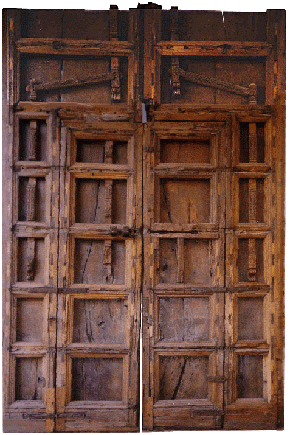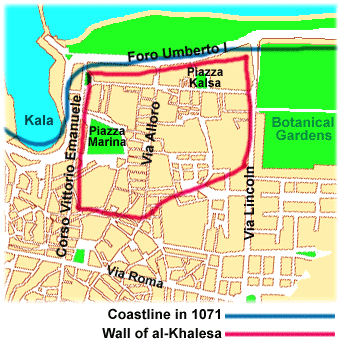...Best of Sicily presents... Best of Sicily Magazine. ... Dedicated to Sicilian art, culture, history, people, places and all things Sicilian. |
by Carlo Trabia | |||
Magazine Index Best of Sicily Arts & Culture Fashion Food & Wine History & Society About Us Travel Faqs Contact Map of Sicily
|
Its construction (using several types of wood including sturdy Sicilian Ash) is typical of the doors built for the squarish entrances of sixteenth-century churches in southern Italy. But even if its connection to medieval history is tenuous, the door's local legend serves to remind us of an event that shaped the destiny of Sicily --and the fact that doors permit us to enter all kinds of places we haven't yet been. The Battle of Palermo stands as one of the most astounding Norman escapades in Italy. It rivals the Battle of Hastings (1066) in importance. Socially, the Normans' occupation of Arab Palermo was far more significant than their conquest of Saxon London, as it brought Sicily back into the European orbit, a development which eventually established an Italianate presence in the central Mediterranean. The Normans had taken Messina during an early morning battle in Spring 1061. In the ten years since, they had sought to consolidate their control of Sicily and the southern part of the Italian Peninsula, fighting Lombards, Byzantines, Arabs and the occasional German. A number of the Normans living in Italy even returned to Normandy and joined the forces of William "the Conqueror" against the Saxons during the conquest of England. In its gradual movement from east to west, the Sicilian campaign was long and hard, partly because Robert "Guiscard" de Hauteville and his younger brother, Roger, were chronically short of trained knights. (Indeed, it would be years following the Battle of Palermo before Enna, an Arab stronghold in east-central Sicily, was taken.) In 1072 Palermo had something over a hundred thousand residents (estimates of 300,000 are probably overstated), but the intrepid Ayub ibn Temim had already been defeated at the Battle of Misilmeri (then Menzil el Emir), outside Palermo, in 1068. On the morning of 5 January, Robert's cavalry attacked the al Kasr district (high ground near what became the cathedral, Piazza Vittoria and the Norman Palace). Fighting was fierce, and penetrating the walls seemed like an impossible feat. Leaving his brother, Roger, to maintain the attack on al Kasr, Robert and some knights attacked al Khalesa, the administrative district on the coast, built around the emir's fortress. This was taken by nightfall, though most of the adjacent al Kasr district,
further inland, remained in Saracen hands. Nevertheless, a Saracen delegation
surrendered to the Normans the following morning. Specifically, the Normans
first entered al Khalesa over a wall near what is now the Spasimo. (In a
corner of this sixteenth-century structure the vestiges of a twelfth-century
Norman-Arab church Here was a historic juncture where Robert and Roger chose to defy convention and their own tradition, where warrior knights accustomed to destroying bridges and breaking doors decided to open the door to social progress. In what was a revolutionary move, Palermo's Moors (Saracens) would be allowed a voice in the new administration of their city. Any mosque that had not been a church (before the Arabs' arrival two centuries earlier) would remain standing, and every man --Muslim, Christian, Jew-- would be judged by his own law. Unlike medieval Europe's other conquerors, the de Hautevilles were seeking to accomodate the conquered --something their descendant, Frederick II, later sought to achieve in Jerusalem as well as Sicily. It was revolutionary, and the Popes didn't like it. Papal Rome wanted to Latinize Sicily as soon as possible, eliminating Orthodox (Byzantine Greek) and non-Christian influences. The Pope would have to wait. Far from the "end" of Muslim society in Sicily, the conquest of Palermo represented the beginning of a truly multicultural nation which for over a century of its existence overcame bigotry and hatred, allowing Christians, Muslims and Jews to live in peace. In the words of John Julius Norwich (author of two books on Norman Sicily): "Norman Sicily stood forth in Europe --and indeed in the whole bigoted medieval world-- as an example of tolerance and enlightenment, a lesson in the respect that every man should feel for those whose blood and beliefs happen to differ from his own." Visibly, Palermo's Arab heritage is preserved in its "Norman-Arab" architecture, unique to Sicily, and in the names of its Kalsa (al Khalesa), Cala (al Kala), and Cassaro (al Kasr) districts. Beneath the wall following Foro Umberto I from Via Lincoln to the Porta Felice gate at the end of Corso Vittorio Emanuele is part of the original seaside wall of al Khalesa, extending from Porta dei Greci (near Piazza Kalsa) along the Mura delle Cattive and into the realm of medieval memory. One would like to imagine that the Saracen emirs and Norman kings would recognise these parts of their beloved city, and the new north-African immigrants in the winding medieval streets who, in another reality, might have been Sicilian Saracens in the city of Roger II and Abdullah al Idrisi. They might well recognise the door that shows the way to religious tolerance and even peace. About the Author: Architect Carlo Trabia has written for various magazines and professional journals, as well as this online magazine. | ||
Top of Page |
 It doesn't look terribly medieval, though scientific dating methods
indicate that some parts of it probably date from around the tenth century.
It isn't kept in a museum but (at least for now) in a corner of the courtyard
of the never-completed Church of Santa Maria dello Spasimo near Piazza Magione
in Palermo's medieval Arabic "
It doesn't look terribly medieval, though scientific dating methods
indicate that some parts of it probably date from around the tenth century.
It isn't kept in a museum but (at least for now) in a corner of the courtyard
of the never-completed Church of Santa Maria dello Spasimo near Piazza Magione
in Palermo's medieval Arabic " can be seen.) The ceremonial entry into Palermo
took place on 10 January, with a Greek Rite mass celebrated by
can be seen.) The ceremonial entry into Palermo
took place on 10 January, with a Greek Rite mass celebrated by